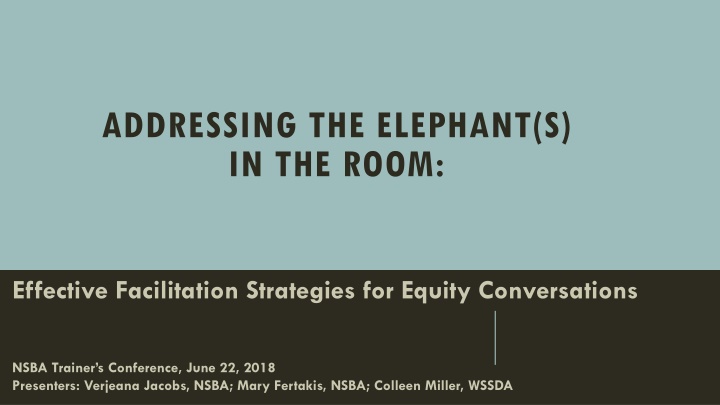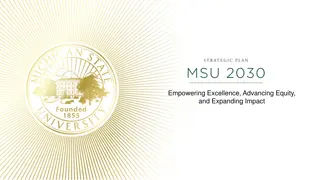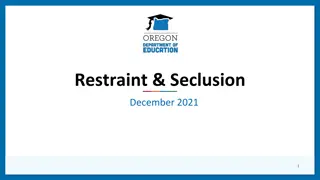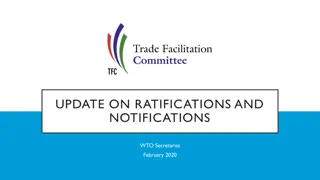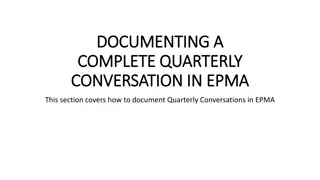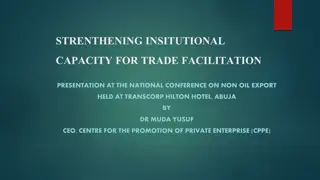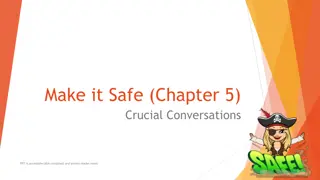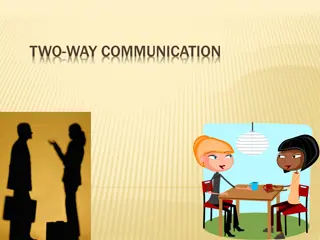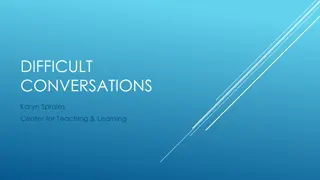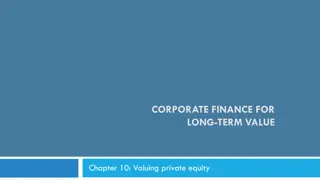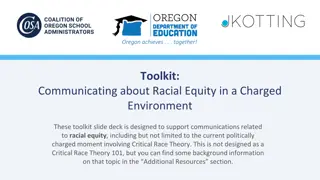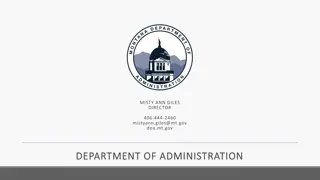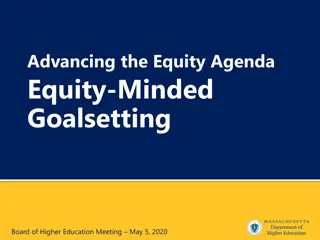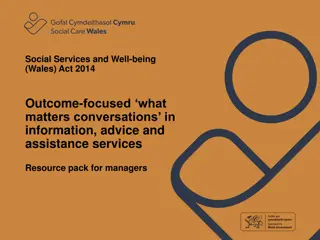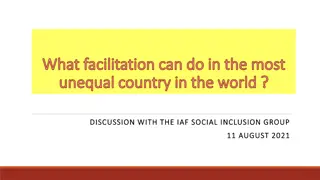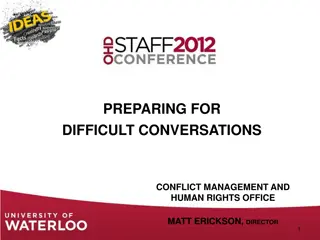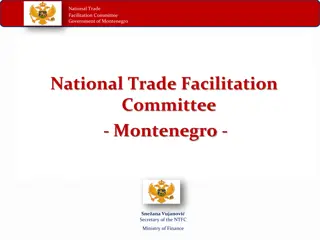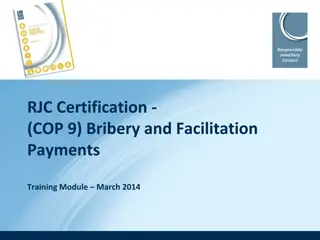Effective Facilitation Strategies for Equity Conversations
This presentation explores effective facilitation strategies for having open conversations about equity, focusing on racial equity discussions, confronting biases, and promoting a learner stance for ongoing learning and growth. Key topics covered include norms for equity conversations, definitions and terminology, responding to pushback, and understanding important terms in race and equity work.
Download Presentation

Please find below an Image/Link to download the presentation.
The content on the website is provided AS IS for your information and personal use only. It may not be sold, licensed, or shared on other websites without obtaining consent from the author.If you encounter any issues during the download, it is possible that the publisher has removed the file from their server.
You are allowed to download the files provided on this website for personal or commercial use, subject to the condition that they are used lawfully. All files are the property of their respective owners.
The content on the website is provided AS IS for your information and personal use only. It may not be sold, licensed, or shared on other websites without obtaining consent from the author.
E N D
Presentation Transcript
ADDRESSING THE ELEPHANT(S) IN THE ROOM: Effective Facilitation Strategies for Equity Conversations NSBA Trainer s Conference, June 22, 2018 Presenters: Verjeana Jacobs, NSBA; Mary Fertakis, NSBA; Colleen Miller, WSSDA
AGENDA 1. Speaker Introductions 2. Norms for Racial Equity Conversations 3. Definitions/Terminology 4. Confronting Our Biases Personal Work Before Working with Others 5. Strategies for Effective Equity Conversations/Presentations 6. Responding to Pushback 6. Q & A
NORMS FOR EQUITY DISCUSSIONS (ADAPTED FROM GLENN SINGLETON S COURAGEOUS CONVERSATIONS ABOUT RACE) Speak Your Truth Stay Engaged Expect to Experience Discomfort Be Aware of Intent; Own Your Impact Accept and Expect Non-Closure Maintain a Learner Stance and Remain Open to New Thinking
LEARNING CONTINUUM FOR RACE-FOCUSED WORK (ANNIE E. CASEY FOUNDATION RESPECT INITIATIVE) Color- Blind Diversity- Only Race- Tentative Equity- Focused
EQUALITY VS. EQUITY (GRAPHIC BY ROBERT WOOD JOHNSON FOUNDATION)
IMPORTANT TERMS IN RACE & EQUITY WORK Race Privilege/White Privilege Racism White Fragility Prejudice Micro and Macro-Aggressions (Interpersonal Racism) Implicit Bias Internalized Racial Superiority Stereotype Threat Internalized Racial Oppression Institutional Racism White Dominant Culture Structural Racism White Supremacist Culture Internalized Racism
RACE Race is NOT biological. Race is a social-political construction that creates a hierarchy of what is desirable (beauty, mannerisms, language, culture, etc.). It s intent is to concentrate power and legitimize dominance over people of color.
INTERNALIZED RACISM Drs. Kenneth & Mamie Clark developed The Doll Test, which showed the negative, psychological effects of racism on children 3-7 years old. Consistently, Black children chose the White doll as their preferred one and assigned positive characteristics to it rather than the Black doll. Their research was part of the testimony during the Brown v. Board of Education trial and was cited in the Court s written decision as to why the separate but equal policy was damaging to children.
INTERPERSONAL RACISM (MICRO-AGGRESSIONS) So like what are you? Courtney, I never see You don t act like a normal Black you as a Black girl. person, ya know. Why do you Can you see as much No you re sound White? as White people you White. know, because of your eyes? eyes?
RACISM (EXAMPLE: CRIMINAL JUSTICE SYSTEM) Police stops: 2x more for Blacks than Whites Prosecution Charges: 2x more mandatory minimum sentences for Blacks for the same crimes as Whites Police searches: 3x more for Blacks/Hispanics Prison v. Community Service: 2x more imprisoned if Black; Whites have higher community service rates Use of force: Police more likely to use on Blacks Juvenile Arrests: 2x more for Black youth Length of Sentence: Blacks more likely to have longer sentences than Whites Gay/Transgender Arrests: Far higher than their percentage of the population (60% are of color) Women: Blacks incarcerated 3x higher than Whites Drug Arrests: Blacks/Whites use at the same rates, but Blacks are arrested 2x more Life w/out Parole: Over 65% are Blacks - and for non-violent offences Marijuana: Blacks are arrested 3.73x more Criminal Records: Whites with a record have a better chance of getting a job than a Black w/out a record. Pre-Trial Release: Blacks more likely to be incarcerated while waiting for trial Voting: 1 in 13 Blacks can t vote vs. 1 in 56 non-Black voters due to felony disenfranchisement.
STRUCTURAL RACISM When I first got here a White parent told me, We run this school. You re just a caretaker, and don t ever forget it. " Students of different races inhabit separate worlds. The school s advanced-track classes are mostly white, as is its well- heeled parent fundraising group, and its annual crop of National Merit Scholars. An area students call the black balcony. The school s white hallway stretches one floor above.
INSTITUTIONAL RACISM (THE 13TH AMENDMENT) Neither slavery nor involuntary servitude, except as a punishment for crime whereof the party shall have been duly convicted, shall exist within the United States, or any place subject to their jurisdiction. Slavery is not mentioned in the Constitution prior to the 13th Amendment it s inclusion provides legal justification for its practice (as a means of punishment). Makes slavery legal in prisons. Led to local governments developing convict leasing programs that generated revenue and increased the profit margins for businesses using convict labor. Incentivized arresting Black and Brown people for an almost-free labor source and increased the growth of the prison industrial complex. (Black Codes -> Vagrancy Laws -> Convict Leasing -> Chain Gangs -> Low Wage Prison Labor) The private prison industry grosses billions of dollars p/yr. (Full facilities = maximum profits) The United States currently has more incarcerated people than any other country in the world.
CONFRONTING OUR BIASES PERSONAL WORK For White People: For People of Color: Randomly read an article current or historical about a group different than yourself. Do not expect POC to teach you about bias, racism, etc. Google/research it yourself. Read; Reflect; Discuss; Caucus. Go to an event sponsored by or hosted by a group different than yourself (ie. Church, an HBCU) or museum or other cultural site. Take the IAT (Implicit Bias Test) on-line. Allow yourself to experience the Stages of Grief. Bolder idea convene a group of people to talk about race and poverty in a small setting. Put yourself in situations where you are the minority and just listen. Personal: An initially unconscious journey the intersection/connectedness of career and personal experiences led to a conscious, purposeful and intentional commitment Corrections, Law school, University professor, School Board, Parent Approach this work from a place of humility. Accept that this is a life-long process and will take on-going, personal commitment to un-learn what has been deeply programmed inside of you.
REFLECTION What are your thoughts about what you have heard so far? On a scale of 1-10, what is your confidence level with leading a race and equity discussion? What personal work do you need to do and/or what professional development would be helpful to increase your confidence level?
STRATEGIES FOR EFFECTIVE CONVERSATIONS Frame the Conversation in the context of the Norms. Conduct an icebreaker that creates an empathetic environment (i.e. Standing in Another s Shoes). Ideally, have both a Person of Color and a White person as co-facilitators. Short agenda with most of the time allocated for discussion. Meet monthly for at least 2 hrs. Ensure that a common definition of Equity/Racial Equity is in place. Ensure that there is a common understanding of the terminology being used. Provide an opportunity for Caucusing with your racial affinity group (structured & facilitated). Provide time for personal, small group and whole group reflection.
STRATEGIES FOR EFFECTIVE CONVERSATIONS The basics - hone the art/skill of listening. Be intentional, purposeful ask yourself - what is the desired outcome of the conversation? Be open- assume nothing about another person s beliefs or understanding. Be aware cognizant of your fears as well as the person(s) engaged in the conversation. Acknowledge/realize discomfort hang in there because this is where learning, change, and impact can happen. Tie a knot and hang on. Be self-reflective actions, motives, and influence.
RESPONDING TO PUSHBACK Understand that one s lived experience shapes their thinking Listen Seek areas of common ground, find comfort zones, use analogies; state facts, ask questions Acknowledge discomfort Assess temperature, bite size as necessary Know when to keep it moving next
RESPONDING TO PUSHBACK (FROM DIVERSITY EQUITY & INCLUSION BY CAPRICE HOLLINS & ILSA GOVAN) Pause the Conversation Acknowledge Comments as Micro-Aggressions Comment on the Reaction that Occurred in the Room Set the Stage to Decrease Defensiveness Remind Participants that we are Here to Learn from Each Other Tie the Conversation/Experience to the Norms Allow Participants to Tell Their Stories Expect and Accept Non-Closure
RESOURCES - FOUNDATIONAL: Courageous Conversations About Race (Glenn Singleton) Blindspot: Hidden Biases of Good People (Mahzarin Banaji & Anthony Greenwald) Whistling Vivaldi (Claude Steele) What Does it Mean to be White?: Developing White Racial Literacy (Robin DiAngelo) Critical Race Theory (Richard Delgado & Jean Stefancic) Race Matters (Cornel West) Dear White America: Letter to a New Minority (Tim Wise) Despite the Best Intentions: How Racial Inequality Thrives in Good Schools (A. Lewis & J. Diamond) Why are all the Black Kids Sitting Together in the Cafeteria? (Beverly Daniel Tatum) White Privilege: Unpacking the Invisible Knapsack (Peggy McKintosh) http://www.cirtl.net/files/PartI_CreatingAwareness_WhitePrivilegeUnpackingtheInvisibleKnapsack.pd f
RESOURCES - CHALLENGING: The New Jim Crow: Mass Incarceration in the Age of Colorblindness (Michelle Alexander) Buried in the Bitter Waters: The Hidden History of Racial Cleansing in America (Elliot Jaspin) Lies My Teacher Told Me: Everything your American History Textbook Got Wrong (James W. Loewen) Sundown Towns: A Hidden Dimension of American Racism (James W. Loewen) An Indigenous Peoples History of the United States (Roxanne Dunbar-Ortiz) The History of White People (Nell Irvin Painter) Black Indians: A Hidden Heritage (William Loren Katz) Just Mercy: A Story of Justice and Redemption (Bryan Stevenson) Tears We Cannot Stop: A Sermon to White America (Michael Eric Dyson) Racism Without Racists: Color-Blind Racism and the Persistence of Racial Inequality in America (Eduardo Bonilla- Silva)
QUESTIONS FOR US?
WE CAN DO THIS! Thank you for attending this session! Verjeana Jacobs: vjacobs@nsba.org Mary Fertakis: mfertakisconsulting@gmail.com Colleen Miller: c.miller@wssda.org
